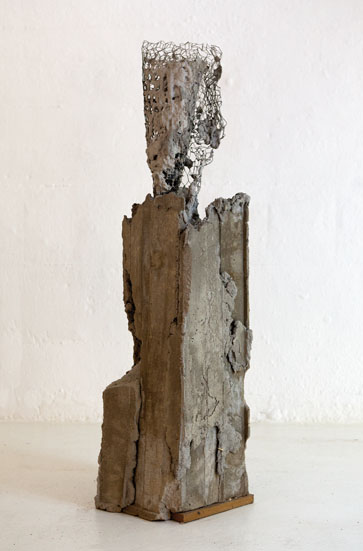Jordi MITJÀ
columna fracturada (monument. lladres del filferro)
DIMENSIONS: 142 x 34 x 32 cm
TECHNICAL: concrete, chicken coop and dm
EDITION:
MODE: escultura

Instruccions d’ús per una columna fracturada / Instructions for use of a fractured column
Jordi Mitjà, 2013
It’s very cold and I realize that I don’t have running water in the workshop. Despite the adversities, I decide to start making the formwork. I use the wood left over from a platform we built by hand for Espai 13. The slats of black pine are too thin,[1] but at this point I don’t know how much force will be applied the concrete inside the formwork. The size of this column will be set by the length of the sleepers, approximately one metre and fifty centimetres. The outcome will be a small beam with the textures of the wood, little knots, cuts and imperfections. That is the idea. I carry on consolidating the box with nails, and I start to get warm from the hammering. Outside a timid sun is shining.
I twist up in the formwork an old length of cloth from a chicken coop that I found in the woods at Can Sis Rals.[2] With some wire and a handrail,[3] I tie the head of the cloth in place on top of the box. This act of foresight will ensure that the cloth does not sink when the concrete is poured in. I prepare the concrete mixer: it’s the first time I’ve used one of these things and it commands my respect. I plug it in and check that it’s turning properly. I have two barrows at the ready, one of sand,[4] which I have passed through a sieve, and the other of concrete.[5] In the shop where I bought the materials they recommended a ratio of four parts sand to one of cement, but I opt for a ratio of 4/2 to be on the safe side. I start to make the mix with water from the pond, where I first had to break up the layer of scum.[6] Nobody has said anything to me about the amount of water, and I pour it in on a hunch. As I shovel in the material a cloud of fine powder escapes from the drum and literally drives me back from the mouth.
I take the opportunity to stop for a bite, and I hear the machine churning. Once the mixing is done I fill formwork up to the box line. I’ve shored it up to spread the weight, it seems that I’ve done a professional job, it looks good. As chance would have it, one of the sides gives way under the pressure and a lot of concrete paste starts to gradually pour out. It does so in slow motion, and I watch the scene like someone watching a show. The concrete seeps out and advances like lava from a volcano, and I see that part of the cloth structure will be exposed to view. At some point in the disaster the concrete stops – I want to think thanks to some divine lump. I close the door and at first give up on the sculpture. A few days later, once the mould is off, this fractured column appears. At that point, I realize that I have the centre post of the project that I’m constructing.
_____________________________________________
[1] I got hold of the black pine sleepers I got as a surplus material for the construction of the AVE high-speed line on the French border.
When we sawed them we were amazed by their smell of resin, a lovely clean pleasant that makes you breathe deeply. We sawed approximately one ton of pine to make the platform for the exhibition. It’s like having breathed in a bit of forest, latent.
[2] The project started out from my knowledge of the work of Josep Pujiula and his constructions in the Can Sis Rals wood in Argelaguer. It was through knowing and adapting this individual’s construction systems that I arrived at the conception of the project: Monument. Lengths of wire for Espai 13 at the Fundació Joan Miró. This forest gives off different smells depending on the time of year, modulated by whether or not water is coming down.
[3] Josep’s hands smell like rust. With many kilos of wire and nails, Josep has built most of the towers, huts and labyrinths of the forest. These rusted materials have an acid smell that is impregnated when working and adheres to them for days.
[4] I use sand from the riverbeds. I learned this from Josep, who always uses it for his constructions with concrete. Marine sand is terrible to work. On walls made with sand from the beach you see that salt trace appear, impregnating them with an unhealthy white mould.
[5] The concrete has one of those smells that suffocates you if you breathe it in and dries up your throat. Now I understand why people who work with it are constantly thirsty.
[6] Stagnant water putrefies and smells of life decomposing, rustic rot.





